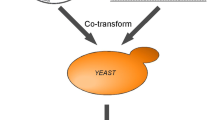Abstract
Despite the advances made in genetic engineering of Saccharomyces cerevisiae, the multicopy genomic integration of large biochemical pathways remains a challenge. Here, we developed a Di-CRISPR (delta integration CRISPR-Cas) platform based on cleavage of the delta sites by Clustered Regularly Interspaced Short Palindromic Repeats (CRISPR) and CRISPR-associated systems (Cas) to enable unprecedented high-efficiency, multicopy, markerless integrations of large biochemical pathways into the S. cerevisiae genome. Detailed protocols are provided on the entire workflow which includes pDi-CRISPR plasmid and donor DNA construction, Di-CRISPR-mediated integration and analysis of integration efficiencies and copy numbers through flow cytometry and quantitative polymerase chain reaction (qPCR).
Access this chapter
Tax calculation will be finalised at checkout
Purchases are for personal use only
Similar content being viewed by others
References
Hong KK, Nielsen J (2012) Metabolic engineering of Saccharomyces cerevisiae: a key cell factory platform for future biorefineries. Cell Mol Life Sci 69:2671–2690
Nevoigt E (2008) Progress in metabolic engineering of Saccharomyces cerevisiae. Microbiol Mol Biol Rev 72(3):379–412
Karim AS, Curran KA, Alper HS (2013) Characterization of plasmid burden and copy number in Saccharomyces cerevisiae for optimization of metabolic engineering applications. FEMS Yeast Res 13(1):107–116
Da Silva NA, Srikrishnan S (2012) Introduction and expression of genes for metabolic engineering applications in Saccharomyces cerevisiae. FEMS Yeast Res 12(2):197–214
Storici F, Durham CL, Gordenin DA, Resnick MA (2003) Chromosomal site-specific double-strand breaks are efficiently targeted for repair by oligonucleotides in yeast. Proc Natl Acad Sci U S A 100(25):14994–14999
de Jong B, Shi S, Valle-Rodríguez J, Siewers V, Nielsen J (2015) Metabolic pathway engineering for fatty acid ethyl ester production in Saccharomyces cerevisiae using stable chromosomal integration. J Ind Microbiol Biotechnol 42(3):477–486
Lee FWF, Silva NAD (1997) Improved efficiency and stability of multiple cloned gene insertions at the δ sequences of Saccharomyces cerevisiae. Appl Microbiol Biotechnol 48(3):339–345
Yamada R, Taniguchi N, Tanaka T, Ogino C, Fukuda H, Kondo A (2010) Cocktail δ-integration: a novel method to construct cellulolytic enzyme expression ratio-optimized yeast strains. Microb Cell Factories 9:32
Christian M, Cermak T, Doyle EL, Schmidt C, Zhang F, Hummel A et al (2010) Targeting DNA double-strand breaks with TAL effector nucleases. Genetics 186(2):757–761
Li T, Huang S, Zhao X, Wright DA, Carpenter S, Spalding MH et al (2011) Modularly assembled designer TAL effector nucleases for targeted gene knockout and gene replacement in eukaryotes. Nucleic Acids Res 39(14):6315–6325
Jakočiūnas T, Bonde I, Herrgård M, Harrison SJ, Kristensen M, Pedersen LE et al (2015) Multiplex metabolic pathway engineering using CRISPR/Cas9 in Saccharomyces cerevisiae. Metab Eng 28:213–222
DiCarlo JE, Norville JE, Mali P, Rios X, Aach J, Church GM (2013) Genome engineering in Saccharomyces cerevisiae using CRISPR-Cas systems. Nucleic Acids Res 41(7):4336–4343
Bao Z, Xiao H, Liang J, Zhang L, Xiong X, Sun N et al (2015) Homology-integrated CRISPR–Cas (HI-CRISPR) system for one-step multigene disruption in Saccharomyces cerevisiae. ACS Synth Biol 4(5):585–594
Shi S, Liang Y, Zhang MM, Ang EL, Zhao H (2016) A highly efficient single-step, markerless strategy for multi-copy chromosomal integration of large biochemical pathways in Saccharomyces cerevisiae. Metab Eng 33:19–27
Luo Y, Huang H, Liang J, Wang M, Lu L, Shao Z et al (2013) Activation and characterization of a cryptic polycyclic tetramate macrolactam biosynthetic gene cluster. Nat Commun 4:2894
Sun J, Shao Z, Zhao H, Nair N, Wen F, Xu J-H et al (2012) Cloning and characterization of a panel of constitutive promoters for applications in pathway engineering in Saccharomyces cerevisiae. Biotechnol Bioeng 109(8):2082–2092
Du J, Yuan Y, Si T, Lian J, Zhao H (2012) Customized optimization of metabolic pathways by combinatorial transcriptional engineering. Nucleic Acids Res 40(18):e142–e142
Gietz RD, Schiestl RH (2007) High-efficiency yeast transformation using the LiAc/SS carrier DNA/PEG method. Nat Protoc 2:31–34
Whelan JA, Russell NB, Whelan MA (2003) A method for the absolute quantification of cDNA using real-time PCR. J Immunol Methods 278(1):261–269
Rozen S, Skaletsky H (2000) Primer3 on the WWW for general users and for biologist programmers. In: Bioinformatics methods and protocols: methods in molecular biology. Edited by Krawetz S, Misener S. Humana Press, Totowa, NJ, pp 365–386
Acknowledgments
We thank Agency for Science, Technology, and Research, Singapore for supporting various research projects in the Metabolic Engineering Research Laboratory (MERL) through the Visiting Investigator Programme to H.Z (1535j00137).
Author information
Authors and Affiliations
Corresponding author
Editor information
Editors and Affiliations
Rights and permissions
Copyright information
© 2019 Springer Science+Business Media, LLC, part of Springer Nature
About this protocol
Cite this protocol
Shi, S., Liang, Y., Ang, E.L., Zhao, H. (2019). Delta Integration CRISPR-Cas (Di-CRISPR) in Saccharomyces cerevisiae. In: Santos, C., Ajikumar, P. (eds) Microbial Metabolic Engineering. Methods in Molecular Biology, vol 1927. Humana Press, New York, NY. https://doi.org/10.1007/978-1-4939-9142-6_6
Download citation
DOI: https://doi.org/10.1007/978-1-4939-9142-6_6
Published:
Publisher Name: Humana Press, New York, NY
Print ISBN: 978-1-4939-9141-9
Online ISBN: 978-1-4939-9142-6
eBook Packages: Springer Protocols




